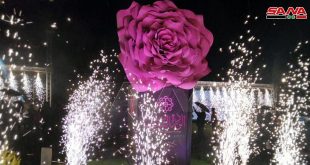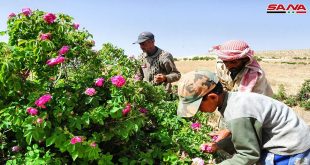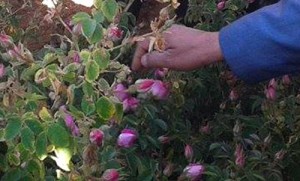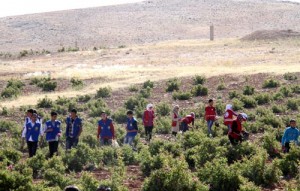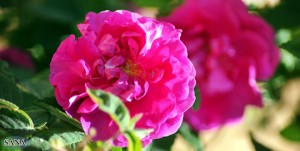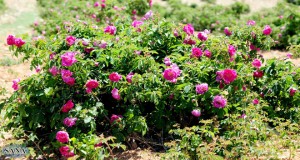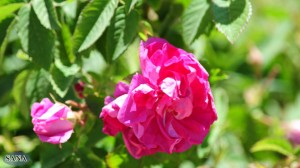Damascus, SANA – Because it’s more precious than gold, and the most famous rose in the world, the locals of a-Marah village in al-Nabek area held a festival for picking the Damask rose. The festival is organized by Damascus Countryside Governorate, in cooperation with al-Marah Damask Rose Association, with mass public and official attendance.
The Damask rose, or Rosa damascena, named after Damascus, has earned fame for its gorgeous color and its fine fragrance. Its shrubs grow up to 2.2 meters tall, and the petals’ hue is a light to moderate pink to light red. The Greek poet Sappho said of the Damask rose “It is the pride of plants, and queen of flowers,” which is possibly the oldest known reference to this rose in literature.
Before the start of rose-picking festival in al-Marah, locals go in droves since early morning to the village’s fields to pick Damask rose buttons that grow there, a spectacle that forms a folk tapestry expressing the locals’ love for this rose and their commitment to preserving it due to its economic, nutritional, aesthetic, and medical importance.
In terms of commercial use, the rose’s most important use is the production of rose oil, known as “rose otto” or “rose absolute” and more commonly known as Bulgarian rose oil. It is used in perfumery as well as pharmacology.
Participants in the festival expressed pride in this type of cultivation since the Damask rose offers much for those who grow it and care for it, asserting that this rose has become an integral part of their lives.
The locals explained that al-Marah is the only area in Syria that cultivates the Damask rose in rainfed fields, and is the primary product of farmers in the village, noting that this isn’t a mere decorative plant, and that interest in the rose has increased since the Syria Trust for Development launched the “Damask rose picking initiative” as part for the program for revitalizing the cultivation of the Damask rose and preserving its local strains by empowering the local community in the village.
Al-Marah is located on the road leading from Damascus to al-Nabk and to Homs, east of the Lebanese borders, and northeast of Saidnaya and Maaloula, two cities that contain some of Syria’s most cherished antique churches and monasteries, with the latter being one of the only three places where Aramaic, the language of Jesus Christ, is still being spoken.
Raya al-Bitar, one of the locals who grow Damask roses, said the importance of this rose lies in the fact that it’s used in various industries, mainly rose oil, rose water, and jam, among others, noting that locals work throughout winter to prepare the lands for planting in spring.
Meanwhile, fellow cultivator Suad Nabhan said locals have been farmers since ancient times, but the cultivation of the Damask rose became more prominent after the care shown by the state to this crop.
Khadijeh Kheja, another local, said the Damask rose is a vital source of income for her, as she specializes and excels in in making rose sherbet, while Mohammad Ata Bakir, a cultivator, stressed the importance of cultivating the Damask rose and the need to expand and preserve this cultivation due to the very high value of the rose and its deep-rooted history.
The Damask rose grows naturally in the Qalamoun Mountains, al-Sheikh Mountain, and some areas in the Ghouta area in Damascus Countryside. It is also cultivated in al-Qastal village near al-Marah, Yabroud area, Erneh, and Aleppo. Despite being a quintessential symbol of Syria in general and Damascus in particular, its economic potential remains largely untapped in the country, but efforts from several sides, both official and civil, seek to change that and transform this captivating flower into a valuable economic resource.
In a statement to SANA, Madian Bitar, head of al-Marah Damask Rose Association which was established in 2010 with the support of the Syria Trust for Development, said the Association looks after all aspects of cultivating the rose and the various issues and difficulties affecting the marketing of this crop.
Bitar said that al-Marah is the only village that has preserved the original Damask rose strain, explaining that its buds are picked and aromatic oil is extracted from them, which is then sold to merchants in al-Bzouriyeh market in Damascus, from which point it is exported to Lebanon and France.
According to Bitar, some of the aromatic oil is produced at the village’s modest facilities and marketed within Syria exclusively for medical products, explaining that the entire season will be sold to international companies working in the field of medicine.
He estimated that the village produces around 60 to 70 tons of Damask rose each year, and that cultivating this rose has made the al-Marah famous, not just locally but internationally, adding that the cultivated area for this season is around 2,500 dunams (250 hectares, or 2,500,000 square meters), and the area was expected to reach 5,000, but the security situation and the difficulties facing farmers in reaching their lands prevented the expansion of the cultivated area.
For his part, Agriculture Minister Ahmad al-Qadiri said participation picking the Damask rose has special significance, continuing a deep-rooted heritage for al-Marah village, adding that it also sends a message to the world asserting that the Syrians’ will to live is strong.
Al-Qadiri affirmed that the Ministry is working continuously to encourage the cultivation of the Damask rose and other medical and aromatic plants, noting that the Ministry provided a series of services for the village, which includes helping in digging a well to provide complimentary irrigation, in addition to providing technical support.
In turn, Damascus Countryside Governor Hussein Makhlouf said that holding the Damask rose festival by the locals and the Association on annual basis shows the official and popular care for this crop on which many people depend due to the fact that this product is used in industries and is a valuable export.
Makhlouf added that the Damask rose received much attention after the visit conducted by Mrs. Asmaa al-Assad to the village in 2007, and after forming the Damask Rose Association which provided training courses for farmers, among other services.
He noted that an area of 5,000 dunams was reclaimed in al-Qalamoun area for the sole purpose of expanding the cultivation of the Damask rose, and there is currently a plan to further increase the reclaimed area for this purpose.
On a relevant note, there are ongoing projects for cultivating the Damask Rose in other areas, including Oum Horan site in Sweida province, with the first stage consisting of the reclamation of 18 dunams for this purpose in 2015 and 32 dunams in 2016.
The Export Development and Promotion Agency studied the economic potential of the Damask Rose. According the Agency’s Director General Ehab Esmandar, the annual production of the Damask rose in 2013 was around 1,000 tons from across the country, with the local market consuming around 50% of the crop.
He said each 4 tons of the flowers or 3 tons of petals produces 1 kilogram of pure rose oil, which is valued between USD 12,000 and 15,000, adding that each kilogram of flowers or 800 grams of petals produces 1 liter of pure rose water, valued at around SYP 800.
Esmandar called for establishing high-tech facilities to produce rose oil, and making a trademarked brand for it to help export and market it abroad.
Scientific research has revealed numerous pharmacological properties to the Damask rose, either on its own or in conjunction with other materials. Anti-HIV, antibacterial, antioxidant, antitussive, hypnotic, antidiabetic, and relaxant effect on tracheal chains have been reported, but the more common therapeutic uses for the rose, specifically rose oil, include repairing broken capillaries, treating dry skin, eczema, and herpes, relieving asthmas, coughs, and hay fever, regulating the menstrual cycle and alleviating its effects, and relieving depression, insomnia, headaches, and nervous tension .
Apart from its therapeutic and cosmetic uses, the Damask rose also has culinary uses; rose water is used mainly in Damascene desserts such as traditional ice cream, rice pudding, nougat, and assorted local sweets, and is often paired with pistachios, another popular ingredient in local cuisine and sweets. Dried petals or whole flowers are also an ingredient in the mixed herbal tea known locally as “zuhurat.” Rose water is most commonly used in Syrian, Levantine, Arab, and Persian cuisine, but it is also used to a degree in Western cuisine, mainly in the making of marzipan and turrón, a type of nougat made in Spain and parts of Latin America.
It should be noted that the Syrian environment is rich in medicinal and aromatic plants, containing 3,646 types of them, 300 of which are listed international pharmaceutical indexes, making them valuable for pharmaceutical production.
Persian scientist and philosopher Avicenna (Ibn Sina) is believed to have invented the process of distilling rose water in the 11th century, as his scientific endeavors in chemistry included using distillation to produce essential oils from materials, one of which was roses, but the origin of rose oil distillation is attributed by some sources to Greece.
The Damask rose was referenced in Shakespeare’s works, with the Bard comparing the color of an unnamed lady’s cheeks to that of “roses damask’d, red and white” in Sonnet 130, in reference to the flower’s pink color that falls between the color of red and white roses. He likewise made the same comparison in the Twelfth Night, writing “But let concealment, like a worm i’ th’ bud, feed on her damask cheek.” Charles Dickens and Oscar Wilde also referenced Damask roses in their works.
Hazem Sabbagh
 Syrian Arab News Agency S A N A
Syrian Arab News Agency S A N A

